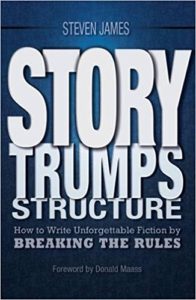
I don’t get writer’s block, but sometimes I need to hit the “pause” button, step back and read a small pile of writing-craft books to fire myself up and make things work better on my novel-in-progress. This week, I felt stuck enough to do an extra-long pause and read a big pile of writing-craft books.
I’m going to share which I found most helpful. My longtime standbys have always been The Writer’s Journey by Christopher Vogler, and Writing the Breakout Novel by Donald Maass. I also like Plot and Structure by James Scott Bell.
But this round, I managed to find a new gem: Story Trumps Structure by Steven James. It more than “unlocked” me; it bolstered and inspired me so that I couldn’t wait to get back to my manuscript. It gave me perspective that numerous other writing-craft books, and the experience of writing nineteen and one-third novels so far (the one-third being the troublemaker this week), never have. Seriously. It was like fresh air. And so easy to read and take in. Very well written.
Two others — Characters and Viewpoint by Orson Scott Card and Bring Your Fiction to Life by Karen S. Wiesner — were somewhat helpful, but not as much so, and not as easy to read. (They felt like of dense, heavy.)
My basic problem was that I’d written four chapters of my novel-in-progress, and overall, was pleased with the writing, pacing and introduction of characters. But I knew the plot itself wasn’t working as planned. I was like a contractor partway into construction who realized the architect’s plans were flawed; I couldn’t fix it without going back to the blueprint and totally rethinking, perhaps starting over.
That doesn’t mean my first four chapters are wasted, I reminded myself. Paragraphs of them can still be used as-is, but in different places than they are now. And parts of them can be used after being thoroughly tweaked. The rest are now valuable backstory, which may or may not show up in the novel at some point, but are crucial for my own expanded knowledge of my characters and plot.
It’s just that the first chapter wasn’t establishing what the main character wanted: the initial goal he’s going to find thwarted. And he lacked depth because I hadn’t spent enough time getting to know him before writing. I’m a plot-driven author who needs to work harder on character depth. (There! I said it!)
But it’s actually okay that I started writing before I should have; sometimes that kick-starts me, and then I pause and go back and firm up my story outline and character depth. It’s just that on this particular project, starting where I’d intended to start wasn’t working. You can’t write yourself out of a flawed outline.
So, using Goodreads‘ site, I checked out 100 novels that involve kidnapping, and found two of those with a storyline vaguely similar to mine. I then used Amazon.com’s “look inside” feature to read the first chapter or two of those books (and some of the others on Goodread’s list), so I got a sense of where other kidnapping stories dropped into the story, how fast they revealed the direction of their plot. Not so I could copy anyone, just so I could contemplate various options.
Between that and the new Story Trumps Structure perspective, I suddenly felt ready, able and enthusiastic about taking my four chapters by the horns, and “starting over” with an entirely new first chapter, but with pieces of the previous chapters ready to slip in where appropriate.
As a tease, I will reveal that my novel is not actually about kidnapping. But it’s about someone and/or something being abducted, and the chase to track them down. That’s all you get to know at this stage. 🙂
Anyway, hope that helps someone else out there. And thanks, Steve James, for being there.
P.S. My favorite past blog on writing: https://pamwithers.com/authors-need-math/

